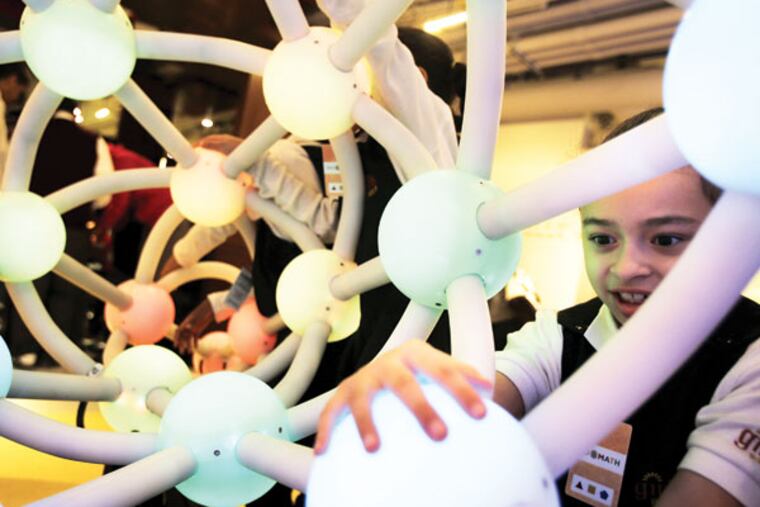Math museum in Manhattan counting on visitors
NEW YORK - The first clue that a new museum here is a bit unusual are the door handles shaped like the Greek letter pi.

NEW YORK - The first clue that a new museum here is a bit unusual are the door handles shaped like the Greek letter pi.
Then there is the elevator. The ground floor is designated with a zero, and the basement is marked "negative one."
And the projected number of visitors in 2013? "Six times 10 to the fourth," said executive director Glen Whitney, a former hedge fund analyst and assistant math professor.
That's 60,000 for those who are a bit rusty on their exponents, but both the rusty and the number-savvy are welcome at the National Museum of Mathematics, said to be the only such museum in North America.
Where else would you find a square-wheeled tricycle? Or a soaring, 14.5-foot parabolic sculpture that you can use to demonstrate the multiplication tables? And check out the Wall of Fire - a curtain of laser light that illuminates the cross-sections of cones, cubes, and other solids.
The museum opened this month on East 26th Street in Manhattan, at the north end of Madison Square Park.
That's just a 0.7-mile walk from Penn Station. At a brisk pace of 4 m.p.h., it takes 10.5 minutes. If you don't believe us, do the ma-. (Sorry. Getting carried away.)
Italy, Spain, and South Korea all have math museums. Germany alone has four. The United States has plenty of science museums, and some of them have a bit of math, such as Ben Franklin's Magic Square puzzles at the Franklin Institute. But why no U.S. museum focused solely on math?
Turns out there was a small one on Long Island, the Goudreau Museum, but it closed in 2006 after not making its numbers. Whitney, who has a Ph.D. in mathematical logic from the University of California, Los Angeles, knew the Goudreau and was saddened to see it go, but then became determined to take things to the next level.
He formed a group of advisers, got a charter from the New York State Department of Education in November 2009, and kicked off a capital campaign, raising $20 million in 18 months from individual donors, corporations, and foundations.
For a start-up museum, private-sector donations are key in this economic climate, said Amy Kaufman, managing director of the United States at Lord Cultural Resources, a global consulting firm that works with cultural institutions. Government support, at least the financial kind, is hard to come by.
"Great ideas can generally get traction, especially when you match those great ideas with great potential funders," said Kaufman, who has advised the organizers of the Museum of the American Revolution, set to open in Philadelphia by early 2016.
Apparently enough people thought Whitney's idea was prime.
"Raising money is never easy, but it was surprisingly easy," he said. "We did strike a chord with a lot of people."
Whitney assembled a board with representatives from education, industry, and finance, including two members from Renaissance Technologies, where he used to work as a hedge fund quantitative analyst. Before that, Whitney taught at the University of Michigan; starting the math museum enabled him to get back into education.
It is designed to appeal to all ages. Each exhibit has its own interactive touch screen on which visitors can select a "basic" or "in-depth" explanation of the math involved, depending on their skill level. There is also a button marked "more math."
The square-wheeled tricycle is sure to be an enduring hit. It has a perfectly smooth ride because it sits on a bumpy surface, consisting of a series of curves called catenaries.
Nearby are the Tracks of Galileo, an adjustable roller coaster of sorts that allows visitors to play with gravity. To be sure, that exhibit is as much physics as it is math - but after all, the two disciplines are inextricably intertwined. Downstairs on floor negative one, check out Harmony of the Spheres, a funky, geometric representation of musical chords. If you touch a sphere, it lights up and you hear the corresponding musical note.
Another exhibit allows visitors to play with the laws of probability by adjusting levers so marbles skitter down in different directions.
There's also a big screen labeled "Formula Morph" that allows users to stretch and twist images of three-dimensional shapes by rotating dials to alter the coefficients in their formulas (i.e., the 4 in the expression "4 times x squared").
As with most museums, there is a gift shop. This one is replete with brain-bending puzzles, math toys, and DVDs of museum-sponsored lectures called Math Encounters.
There also are some books with vaguely naughty-sounding titles: Prime Obsession, X and the City, and The Joy of X. The last one is subtitled "A guided tour of math, from one to infinity," which makes it sound like a long book. Turns out it is an efficient 256 pages. (16 squared!)
Whitney, the executive director, could hardly contain his excitement during a recent media preview.
"I like to play," he said, explaining how the exhibits were chosen. "I like to get my whole body moving."
There is a high probability others will agree with him.
For Information
To find out more about the the National Museum of Mathematics, visit http://momath.org or call 212-542-0566.
EndText